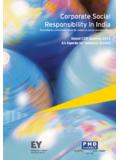Transcription of Government of India NITI Aayog (National Institute …
1 Government of India NITI Aayog ( national Institute for transforming India ) (PPPAU Division) ** Sansad Marg, New Delhi 110001 Dated: 16th October 2017 NOTICE Subject: Inviting comments from the general public, Government Ministries and all the other stakeholders on the Draft Model Public Private Partnership Policy Guidelines in Integrated Micro-Irrigation in India regarding. ** In order to facilitate the participation of private sector and to integrate various Government subsidies at the farm level, with the objective to promote participatory farming at scalable levels and increase farmer s income by employing more efficient means of irrigation, NITI Aayog has prepared Draft Model Public Private Partnership Policy Guidelines in Integrated Micro-Irrigation in India .
2 2. The general public, Government Ministries and all the stakeholders are invited to send comments/ views, if any, on the captioned Concept Paper, which is attached herewith, to the undersigned latest by 30th November 2017 (Aman Hans) Consultant Public Private Partnership| NITI Aayog Email: Guidelines Micro Irrigation through Public Private Partnership From The Source To The Roots - Draft Concept Note NITI Aayog ( Government of India ) PPPAU Division ------------------------------- October 17 Public Private Partnership in Integrated Micro-Irrigation in India NITI Aayog | PPPAU Division | DRAFT CONCEPT NOTE Page 3 Table of Contents ABBREVIATIONS .. 4 1. PREFACE .. 5 NEED FOR MICRO-IRRIGATION .. 5 Government SPONSORED SCHEMES .. 7 2. PUBLIC PRIVATE PARTNERSHIP.
3 8 THE CONCEPT .. 8 PPP FOR INTEGRATED MICRO-IRRIGATION IN India .. 9 3. PROPOSED PPP-IMI SCHEME .. 10 KEY FEATURES .. 10 IMPLEMENTATION METHODOLOGY .. 11 PRE-BID ACTIVITIES .. 12 ROLES AND RESPONSIBILITY OF CONCESSIONAIRE .. 13 ROLES AND RESPONSIBILITY OF FPC S/ BENEFICIARY FARMERS .. 15 ROLES AND RESPONSIBILITY OF THE STATE Government .. 16 4. PAYMENT MECHANISM: .. 17 DISBURSEMENT LINKED TO OUTPUT PARAMETERS .. 19 5. TRANSACTION STRUCTURE .. 19 6. BIDDING PROCESS .. 20 SELECTION OF THE BIDDER .. 20 CONCESSION AGREEMENT .. 22 7. EXPECTED OUTCOMES .. 24 8. TIME FRAME .. 24 Public Private Partnership in Integrated Micro-Irrigation in India NITI Aayog | PPPAU Division | DRAFT CONCEPT NOTE Page 4 ABBREVIATIONS CLR : Marginal Cost Lending Rate CPI : Consumer Price Index CSS : Centrally Sponsored Scheme DBFMT : Design, Build, Finance, Maintain and Transfer DEA : Department of Economic Affairs DIP : District Irrigation Plan EOI : Expression of Interest FPC : Farmer Producer Company FY : Financial Year Ha : Hectare IMI : Integrated Micro-Irrigation LOA : Letter of Acceptance MCLR : Marginal Cost of Lending Rate MI : Micro Irrigation MNREGA : Mahatma Gandhi national Rural Employment Guarantee Act.
4 2005 MoA : Ministry of Agriculture, Govt. of India MSCA : Modified Swiss Challenge Approach NCA : Net Cultivated Area NIA : Net-Irrigated Area NMMI : national Mission on Micro Irrigation NMSA : national Mission on Sustainable Agriculture NBV : Net Book Value NPV : Net Present Value OBS : Output Based Specifications OFWM : On Farm Water Management PMC : Project Management Consultant PMKSY : Pradhan Mantri Krishi Sinchayee Yojana PPP : Public Private Partnership RFP : Request for Proposal RFQ : Request for Qualification SBI : State Bank of India SIA : State Implementation Agency TPC : Total Project Cost WPI : Wholesale Price Index WUA : Water User Association Public Private Partnership in Integrated Micro-Irrigation in India NITI Aayog | PPPAU Division | DRAFT CONCEPT NOTE Page 5 1. PREFACE Water being a necessity for crop production is one of the most important natural resources for sustaining human life on earth.
5 In the context of the Indian economy, the demand for this limited resource is increasing day-by-day due to two critical reasons. First, owing to the presence of large tracts of arid and semi-arid land, where the surface and sub-surface water resources are highly limited. Second, the spurt in industrial and domestic consumption of water due to a high rate of population growth that has exponentially increased the demand for this limited commodity in India . Furthermore, over-exploitation is depleting the existing water resources at critical rates, even in areas traditionally known for having abundant irrigation water supply, resulting in irrigation water becoming both scarce and expensive. Now, in order to feed the growing population and to further increase farm incomes and livelihood of farmers in India , the overall agricultural production needs to be increased.
6 One of the key ways to boost overall agricultural production is to implement better soil-water management techniques that would provide the arid and semi-arid lands better access to irrigation water, without actually increasing the stress on available water resources. NEED FOR MICRO-IRRIGATION Globally, it s well established that Micro Irrigation ( MI ) technologies increase crop yield, save water, improve crop quality, enhance the fertilizer/ chemical application efficiency, conserve energy, reduce labour cost, improve pest management, increase feasibility of irrigating difficult terrains, improve suitability of problem soils, improve tolerance to salinity etc. In MI, supply of optimum quantity of water in the form of tiny streams, fine spray or continuous drops mitigates water loss due to evaporation and on account of seepage and percolation.
7 This further reduces water logging and improves soil health. Consequently, there is an increase in productivity and the quality of produce, thereby leading to a rise in the overall farm incomes. MI technology is promoted primarily for the following reasons: (1) as a means to save water in irrigated agricultural land (hereinafter referred to as the Command Area ); (2) as an initiative to increase farmer incomes and reduce poverty; and (3) to enhance the food and nutritional security of rural households. Also, substantial dependence on rainfall makes cultivation a high risk and less productive activity, so assured irrigation and in-situ moisture conservation encourages farmers to invest more in farming technology and inputs that lead to productivity enhancement and increased farm income.
8 Further, the rate of return vis- -vis farm productivity from investment in drip-irrigation is observed to be relatively higher than that of sprinkler irrigation and can be as high as 150%. Understandably, the minimum payback period has been found to be less than 1 year and the maximum to be 2- 3 years in both Public Private Partnership in Integrated Micro-Irrigation in India NITI Aayog | PPPAU Division | DRAFT CONCEPT NOTE Page 6 drip and sprinkler methods1. A suitable framework to channelize investment into micro-irrigation in India will generate a beneficial social impact on farmers and positive environmental impact along with a rational financial return for the investor. A comparison among irrigation efficiencies of flow, sprinkler and drip irrigation is shown in the figure below: Figure 1: Comparison: Flow, sprinkler and drip Source: Accelerating growth of Indian agriculture, GT & FICCI 2016 CURRENT STATUS OF MI IN India Out of approximately160 million Ha of cultivable land in the country, only approximately65 million Ha (41%) is currently covered under irrigation (for FY 2012)2.
9 The current area under MI in India is only million Ha3 compared to the potential of million Ha4. Of the million Ha under MI in India , million Ha is under sprinkler irrigation ( ), while million Ha is under drip irrigation ( ). States with the largest area under MI include, Rajasthan ( million Ha-20% share), Andhra Pradesh ( million Ha-15% share), Maharashtra ( million Ha-15% share), Gujarat ( million Ha-13% share), Karnataka ( million Ha,-11% share), and Haryana ( Ha-7% share). These six states cover 81% of the total area under MI in the country. Information on the area under drip and sprinkler irrigation as per December 2016, provided by Ministry of Agriculture and Farmers Welfare are set out in Annexure-2 of this note. The potential for adoption of MI by a state is positively correlated to the 1 Source: Evaluation Study on Integrated Scheme of Micro-irrigation, Planning Commission, FY 2015 2 Source: MoA, Horticultural Statistics-2016 3 Source: MoA, December-2016 4 Source.
10 MoA, Task Force on MI, 2004 50-60(Canal) 60-70 (Well) 40-70 30-40 30-35 60-80 30-40 50-70 90 20-25 80-90 0102030405060708090100 Conveyance EfficiencyApplication EfficiencySurface water moistureevaporationOverall efficiencyPercentage Water usage efficiency under various irrigation systems Surface irrigationSprinkler irrigationDrip IrrigationPublic Private Partnership in Integrated Micro-Irrigation in India NITI Aayog | PPPAU Division | DRAFT CONCEPT NOTE Page 7 proportion of net-irrigated area ( NIA ) to net cultivated area ( NCA ) and over-exploitation of ground water resources, and negatively correlated to the extent of rainfall5. Government SPONSORED SCHEMES Irrigation has been classified as a State subject in the Seventh Schedule of the Indian Constitution and has been given Infrastructure status as per the notification on Harmonized Master List of Infrastructure Sub-Sectors, dated 30th March 2017 by the Department of Economic Affairs, Ministry of Finance.















